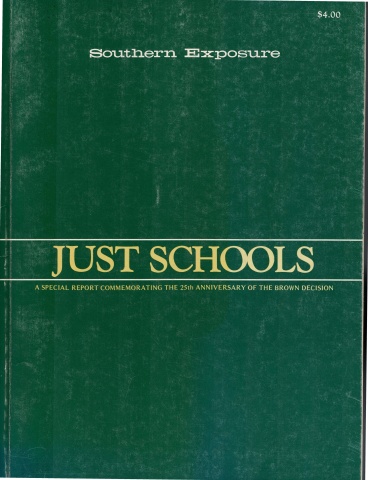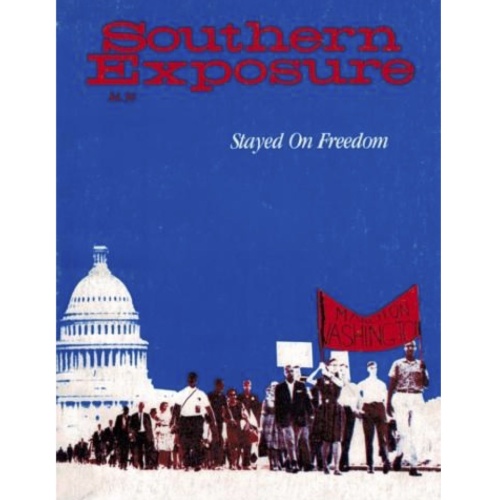Prince Edward, 1954-1959: “Our White Case is Lost”

This article originally appeared in Southern Exposure Vol. 7 No. 2, "Just Schools: A Special Report Commemorating the 25th Anniversary of the Brown Decision." Find more from that issue here.
"Barrye Wall came to me on the street one day and said, 'Bob, the Negro organization of the NAACP has made right much progress in recent years. It's not the type of progress that we like, but it's done in an orderly way, legally, and with plenty of money and smart lawyers. We ought to organize the same way and see what we can do.'"
Barrye Wall - editor of the Farmville Herald - and Bob – Bob Crawford, laundry owner and sometime school board chairman – joined with other Southside Virginia political and business leaders soon after their 1954 conversation to build an organization to fight desegregation. One month after the Brown decision, Wall and Crawford and 70 other Virginia leaders, including 20 Fourth District state senators and representatives, met in Petersburg. This meeting, known now as the Petersburg Firehouse meeting, set the tone for resistance across the South. Massive resistance was born. Five days later the resistance movement began to dig in its heels. Governor Thomas B. Stanley declared that he would use "every legal means at my command to maintain segregated schools.”
In the coming weeks, meetings were held in both Farmville and Petersburg, and the new organization took its name: "The Defenders of State Sovereignty and Individual Liberty." The Defenders pledged to maintain states' rights, individual rights, and segregation in the schools. In October, 1954, the organization had a state charter and 2,000 members. Its true strength was even greater than its numbers suggest: for example, in Prince Edward County, the Defenders controlled
the local government through the organization's directors, which included the mayor, [illegible], a former school board chairman, a newspaper publisher and a local tobacco manufacturer. Virtually every Southside Virginia community was similarly organized.
The Defenders, as befitting pillars of the community, were careful to [illegible] violence and the extreme racism of the Klan or the White Citizens Council. Defenders statements stressed states’ rights, private enterprise and a [illegible] interpretation of the Constitution, with segregation added almost as an afterthought. But, although the Defenders kept clear of the Klan’s tactics - "If this community should suffer just one incident of Klanism, our white case is lost" - their goals were identical.
The attack on the public schools began in spring of 1955 when the Prince Edward Board of Supervisors voted to delay appropriating funds until the last possible moment. They met again on May 31, just hours after the second Brown decision ordered desegregation "with all deliberate speed." Before a packed house, the Board approved Supervisor John Bruce's motion to appropriate only the legal minimum of $150,000, a fraction of the amount needed to operate the county's schools. Hours after the Supreme Court ordered desegregation, Prince Edward became - as the Defenders had intended – the national symbol of defiance, of the inapplicability of desegregation by decree. Prince Edward would, in effect, close its schools rather than comply.
Prince Edward leaders chose "reasoned" defiance, ostensibly in support of state law and locally controlled education. More importantly, the Prince Edward strategy was designed around a long-term struggle. Even before the May 31 vote, Wall had observed that public education would have to be replaced rather than just eliminated. At a mass meeting held at Longwood College on June 7, with the heads of several local PTAs on the speakers' platform - all acting as individuals, all staunch Defenders - the issue came to a head. The Defenders had prepared well: supporters of public schools, unwilling to defend integration, could only present a lukewarm case. The meeting ended with a vote of 1,250 to 25 in favor of Mayor W. C. Fitzpatrick's motion to establish a private corporation to raise funds to pay white teachers should schools be closed. The implication was that the white teachers would continue teaching in new private schools. By mid-July the Prince Edward Educational Foundation, synonymous with the Defenders, had collected $180,000 in pledges. No ad hoc body thrown together at the Longwood meeting, the Foundation was the end product of careful planning by Defender leadership, based on the expectation of abandoning the public schools for segregated private schools.
When a federal court postponed desegregation on July 18, 1955, the Foundation accepted the move as a respite, but continued to hold the pledges. As Herald editor Wall wrote, "Its work has not ended; it has just begun." When the NAACP sought a court order for desegregation by fall of 1956, the county responded quickly with a petition signed by 4,184 people (about 8,460 whites, including children, lived in Prince Edward) opposing desegregation; the Board of Supervisors reaffirmed its pledge not to appropriate money for integrated schools.
In September, 1958, the statewide resistance, of which Prince Edward had been a leader, reached its climax. Under state law, 12,000 children in Norfolk, Front Royal and Charlottesville were locked out of schools which had been desegregated under court decree. In January, 1959, the courts struck down the state's massive resistance laws. Thirty black children began to attend formerly white schools in three communities. The crisis in most of Virginia was over.
But in Prince Edward, under court order to desegregate public schools by the following September, the crisis began in earnest. On June 2, 1959, the Board of Supervisors voted not to appropriate money to operate public schools. Led by Farmville's Roy Pearson, an official of Standard Oil, the local white community – assisted by donations from throughout the United States - turned out in force. The organizational staff included a Foundation director for each school district, the president of each PTA and the local school principals. By September, the private schools, Prince Edward's "experiment in ignorance," were opened with a speech by Pearson: 'The spotlight will be on you and your accomplishments. If we have a
successful year, the hopes of hundreds of thousands will be kindled."
Prince Edward had been a focal point of resistance since 1954. It became, after 1959, a testing ground for the new segregationist academies, a continuing symbol of resistance to federal edict, resistance to equal education, resistance to change.
Tags
Southern Exposure
Southern Exposure is a journal that was produced by the Institute for Southern Studies, publisher of Facing South, from 1973 until 2011. It covered a broad range of political and cultural issues in the region, with a special emphasis on investigative journalism and oral history.
